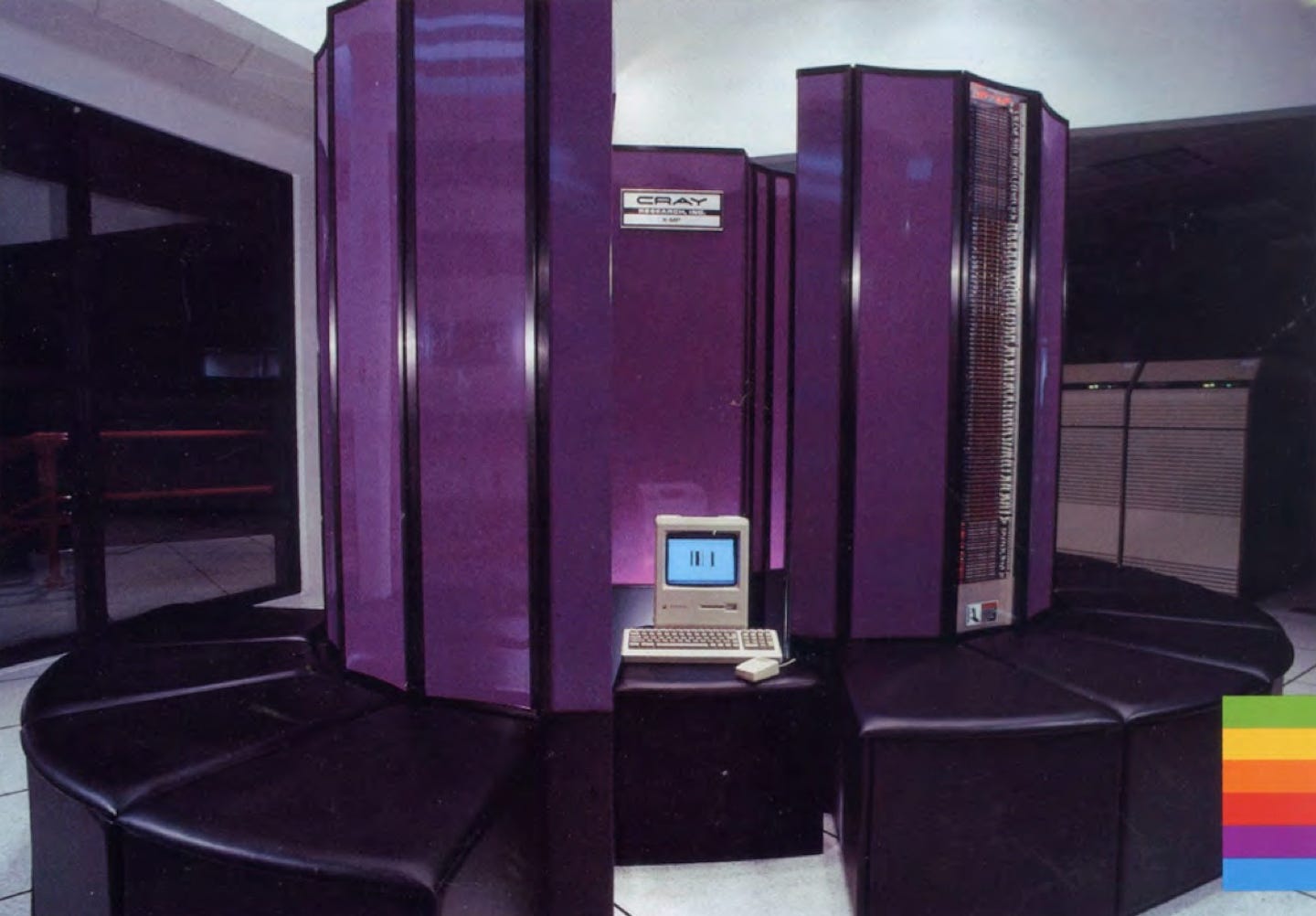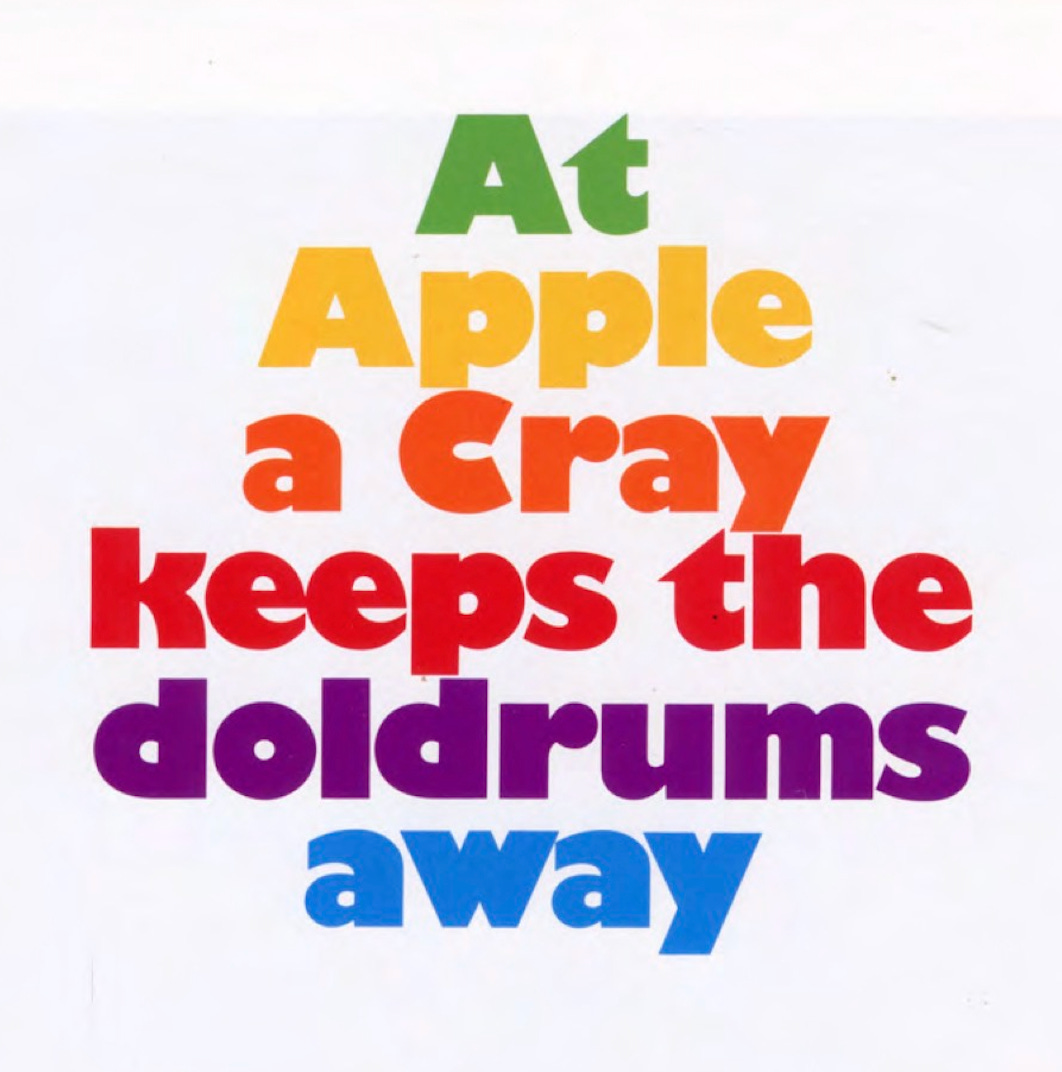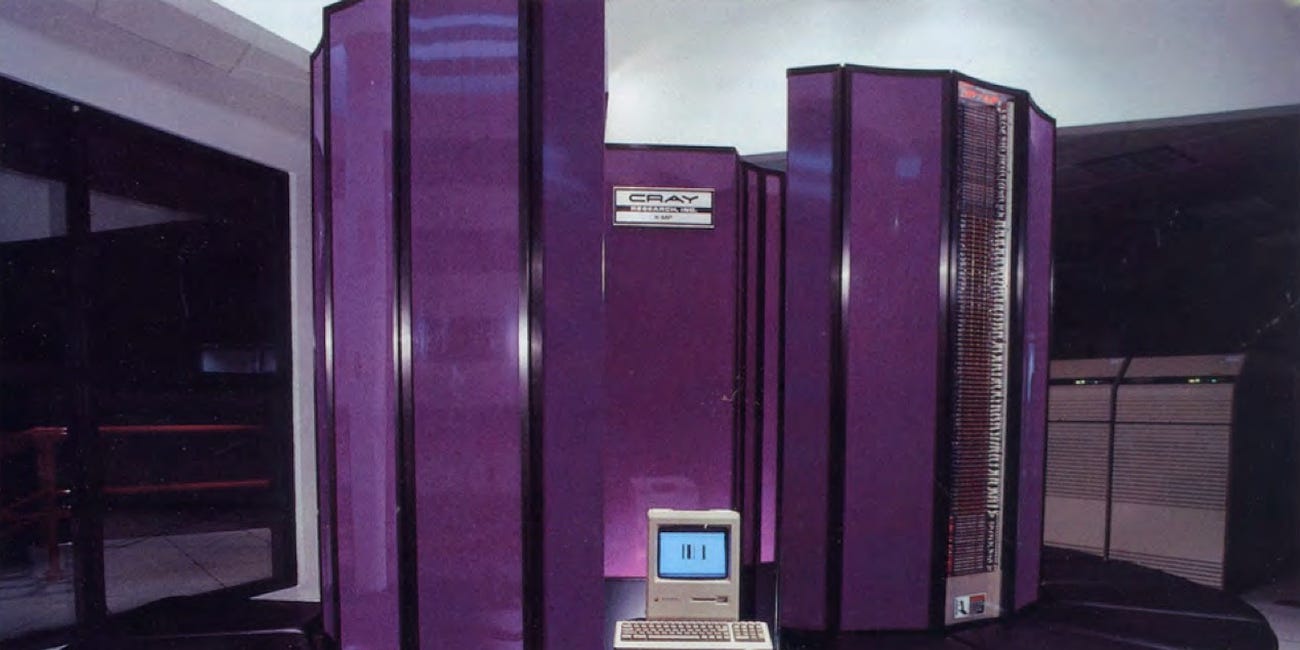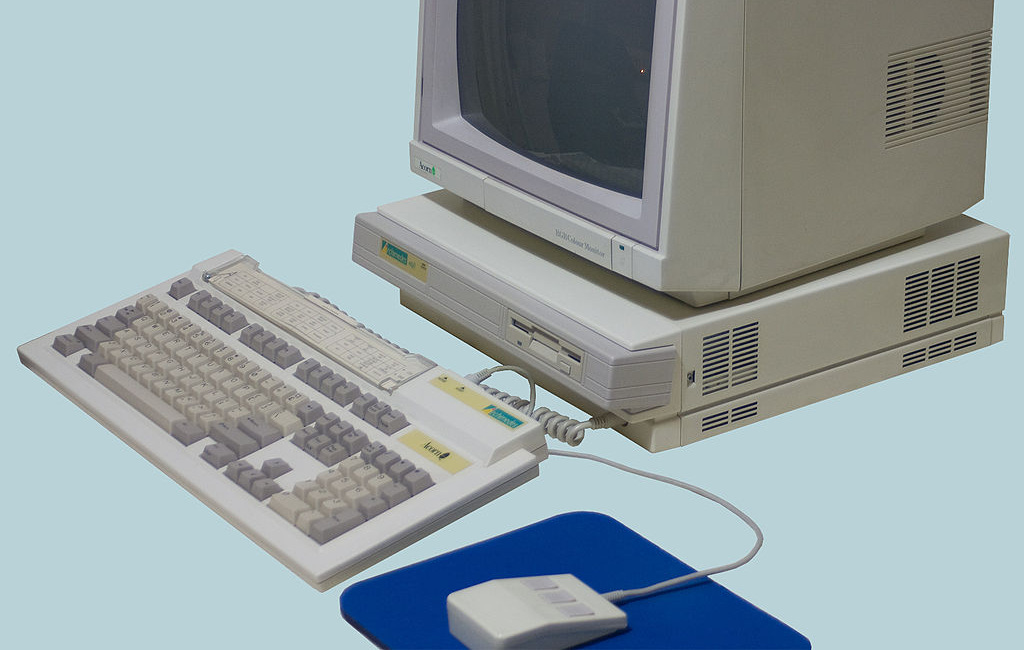

The First 'Apple Silicon' : The Aquarius Processor Project
source link: https://thechipletter.substack.com/p/the-first-apple-silicon-the-aquarius-7cb
Go to the source link to view the article. You can view the picture content, updated content and better typesetting reading experience. If the link is broken, please click the button below to view the snapshot at that time.

The First 'Apple Silicon' : The Aquarius Processor Project
Apple’s first attempt to build its own processor - using a Cray supercomputer.
Apple’s own System on Chips (SoC) designs used in iPhones, iPads and now Macs (with ‘Apple Silicon’ branding) are a key source of competitive advantage for the Cupertino giant. The Arm instruction set compatible, but Apple designed, processors used in these SoCs, consistently outperform competitors’ designs.
Apple is the modern exemplar of the maxim from Herman Hauser, founder of Acorn, Apple’s partner in the original Arm joint venture, that ‘there will be two types of computer company in the future, those with silicon design capability and those that are dead’.
But Apple’s first attempt to design its own processor came over twenty years before the appearance of the first iPhone. We’ve seen in the RISC Wars Part 1: the Cambrian Explosion how, as the 1980s progressed, almost every semiconductor manufacturer and computer maker felt the need to have their own processor design. Apple was no exception.
The Mac was launched in 1984 using the Motorola 68000 processor. By 1986, Apple, along with other firms building 68000 powered machines, could see the performance advantages of using one of the new RISC processor designs.
Steve Jobs had departed Apple in 1985 and Apple was now being run by CEO John Sculley. The head of the Mac division, John-Louis Gassée, and Sculley were persuaded that Apple should take control of their fate by designing their own processor. According to Gassée:
Apple engineer Sam Holland came up with another, longer-term idea: Let's develop a quad processor of our own for future Apple personal computers, one that would dramatically outpace the evolution of Intel and Motorola chip development, guaranteeing the Mac's place at the industry's pinnacle.
Holland was put in charge of the project – known as ‘Project Aquarius’ – within Apple’s Advanced Technology Group. The specification of the processor was to be known as Scorpius (a constellation near the centre of the Milky Way) and the initial implementation was to be known as Antares (which is the brightest star in the Scorpius constellation).
Designing with the Purple Cray
With John Sculley’s backing, the Aquarius project had access to extensive resources. At one point, there were over fifty staff working on the design. For simulation and other design tasks, Sculley allowedd the project to purchase a Cray ‘supercomputer’. In fact, legend has it that Sculley himself made the first call to the Cray sales team. The Cray X-MP/48 reportedly cost $15 million and was set up in its own dedicated building, which was made ready in record time:
Apple's rapid acquisition of a supercomputer may seem miraculous to anyone familiar with the usually lengthy process. But our need for supercomputer capabilities was clear, and the lack of bureaucratic obstacles within the company hastened the process considerably. As a result, Apple boasts one of the fastest Cray system installations to date, having prepared its installation site in only six weeks.
For most of these six weeks, crews worked three shifts, 24 hours a day, seven days a week preparing a machine room for the system. The crews gutted the building, installed the cooling tower, the chilled water and high-pressure freon plumbing, the wiring, the air conditioning, the walls, and the false floor.
The Aquarius project was supposed to be secret, but secrecy was hard to maintain with a dedicated building containing an expensive computer like the Cray. As if the new Cray wasn’t visible enough, it even got its own distinctive colour – purple. To try to maintain the subterfuge, Apple’s management invented the cover story that the machine was being used to develop ‘visual interfaces’ for the next generation of the Macintosh.
One contemporary account gives a sense of the complexity of the setup which involved Macs, Sun Workstations and VAX minicomputers as well as the Cray:
The Hyperchannel links the Cray to several nets of Apple Macintoshes via a VAX-11/785, a VAX-11/780, and a Sun/2. The Macs are linked to the VAXes and the Sun via AppleTalk in series with Ethernet. Ethernet and AppleTalk are bridged by a converter system from Kinetics Inc.
On paper, the Cray looked very powerful for the era:
The top-end system was the X-MP/48, which contained four CPUs with a theoretical peak system performance of over 800 MFLOPS and 8 million words of memory.
But there were multiple problems. First, the software needed to design the Aquarius chips ran under Unix. The Apple machine thus became the first Cray installation in the world to run Unix, specifically Unix System V from AT&T who Apple worked with to design the new processor.
Second, the Cray was a ‘vector machine’, built to run a certain class of programs quickly: those that could be broken up into smaller tasks and run in parallel. This wasn’t an approach that could be easily applied to the tasks that the Aquarius team needed. In due course, the team found that the Sun workstations that they attached to the supercomputer could run their software just as quickly as the Cray itself.
Scorpius Architecture
Whilst other firms were following the example of the pioneering RISC designs from Berkeley and Stanford, Apple started off by going down a different route.
The first version of Aquarius wasn’t RISC at all, but a stack architecture design. Rather than use a conventional cache, the design also placed heavy reliance on software and the compiler to manage the transfer of memory into and out of the processor when needed. When the compiler team indicated that building the software to do this was impossible, the design was changed to a more conventional RISC design.
But even after these changes, the Aquarius design was both novel and ambitious. From a late version of the Scorpius specification:
Scorpius is a tightly-coupled multiprocessor CPU with efficient support for fine-grained parallelism; the architecture was developed to take advantage of the inter-connectivity of single-chip VLSI implementations. Scorpius is intended to be the processing element of a high-performance personal computer system constructed with a minimal number of components. A Scorpius CPU comprises four independent processing units (IPUs) which share access to separate instruction and data caches, a Memory Management Unit, and a Memory/Bus Interface.
The independent processing units (IPUs or PUs) were processor cores in the modern sense:
IPUs have a small register-oriented instruction set in which all data access to memory Is done by register load and store instructions. (Register and word size is 32 bits.) Each PU has 16 general-purpose registers — a total of 64 for the CPU — and 7 local registers. Local registers include product, remainder, prefix, and various state saving registers. In addition, the four PUs share 8 global registers. Including interrupt, event counter, and global status registers.
Holland’s background had been in supercomputers, which perhaps influenced the decision to buy the Cray. It probably also influenced the design of Aquarius, which, like a supercomputer, focused on parallel computing with several modes of parallel execution. For example, it had a Single Instruction Multiple Data (SIMD) mode:
SIMD (Single Instruction stream, Multiple Data streams). This mode corresponds to the usual View of parallel processing: each PU executes the same operation on different data streams.
All this seems very forward looking but could Apple build Aquarius?
Aquarius Sinks
All the new features included in the Scorpius design meant that they lost one of the key advantages of the RISC approach: simplicity. Small teams at UC Berkeley and Stanford, and then at Acorn in the UK, had successfully designed and built working RISC processors in little more than a year. At Apple, even with a team of fifty, the design struggled to make progress.
Sam Holland left to be replaced by the creator of the ‘Pong’ video game at Atari and now an Apple fellow – Apple’s most senior engineering role – Al Alcorn. According to Alcorn:
It was getting ugly. It was going nowhere, budgets. And I was asked by the troops, would I take over the project? It was considered career suicide. This was awful and they realized that in my position as an Apple Fellow, I had nothing to prove, so I could take on a case like this. I was intrigued by very bright people and tried to salvage the project.
Alcorn in turn recruited Hugh Martin from Ridge computers, the creators of an early 32-bit RISC processor design. Martin reportedly described the Scorpius design as ’ridiculous’ to both Alcorn and Sculley. Apple would be better to focus on its strengths rather than try to compete with industry giants like Intel and Motorola.
Eventually, Alcorn realized it was hopeless, despite the ‘very, very bright people there.’ He brought the Aquarius project to an end in 1989.
The Cray was put to work on other work, including, according to legend, running the injection modelling software MOLDFLOW to help design Mac cases. An ignominious end for such a powerful machine.
History hasn't recorded whether the project actually built any actual silicon. The lack of any record or mention of a prototype suggests that they never built a working system though.
The Lost Age of Aquarius?
From the perspective of the 2020s, this can all seem like a lost opportunity. If a small company Acorn could design its own RISC processor in 1985, then Apple would have been able to if it had built a simpler RISC design. Perhaps, we would now be using Macs with the latest version of an architecture that Apple had used continuously for over 35 years. Those processors might even have made Apple more competitive in its most difficult years in the 1990s.
Perhaps. It's always dangerous to try to rewrite history. Apple didn’t need its own CPU design at this point. The 68000 would be replaced by the PowerPC RISC architecture, and Apple would gain access to the resources of IBM and Motorola, which was probably a better outcome than could have been achieved by Aquarius.
Quoting Gasee though:
Although the quad processor development work didn't produce direct results, the Aquarius project stands as an early example of Apple's abiding desire to control the future of its hardware …
It’s that abiding desire that has brought us Apple Silicon in the 2020s.
The supplement to this week’s edition includes a look at the Scorpius design and at Apple's use of the Cray supercomputer. Thanks to everyone who has supported The Chip Letter by becoming a paid subscriber.
The Chip Letter is a reader-supported publication. To receive new posts and support my work, consider becoming a free or paid subscriber.
PS: If you enjoyed this you might also like this about the partnership between Apple and Acorn computers that led to Advanced RISC Machines.
Recommend
About Joyk
Aggregate valuable and interesting links.
Joyk means Joy of geeK



